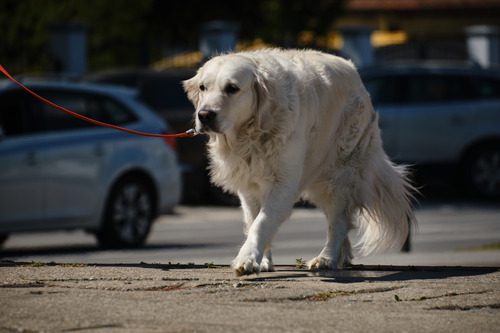What is Limber Tail?
If you’ve noticed that your dog’s tail suddenly looks limp and lifeless, they might be experiencing a condition called limber tail. This syndrome, also known as acute caudal myopathy, can be alarming for pet owners, especially if their dog is usually energetic and wagging nonstop. While it’s often associated with working breeds, any dog can develop a limber tail. In this blog, we’ll help you understand what causes this condition and how to respond to help ease your concerns and ensure your pet gets the care they need. If you have any concerns about your dog’s overall well-being, call Sahara Pines Animal Hospital at (702) 876-7580 or book an appointment online today.

What Causes Limber Tail?
Limber tail occurs when the muscles at the base of a dog’s tail become strained or overworked. This condition is most commonly seen in active dogs, particularly those who engage in swimming, excessive exercise, or prolonged confinement. Some of the key causes of limber tail include:
- Overexertion – Dogs who engage in intense physical activity, such as hunting or agility training, can develop limber tail due to muscle fatigue.
- Swimming in Cold Water – Cold temperatures can contribute to muscle inflammation and stiffness, increasing the likelihood of limber tail in dogs who swim often.
- Crating for Extended Periods – Dogs that spend prolonged time in a crate, especially during travel, may develop limber tail due to restricted movement.
- Sudden Temperature Changes – Exposure to cold weather or bathing in cold water can trigger muscle soreness and contribute to limber tail.
- Trauma or Injury – A direct impact to the tail or excessive wagging against a hard surface can lead to inflammation in the muscles at the base of the tail.
Recognizing the Symptoms of Limber Tail
Limber tail is fairly easy to identify, as it presents with distinct physical and behavioral signs. If your dog is experiencing limber tail, you may notice:
- A limp or droopy tail that hangs down instead of wagging normally
- Discomfort or pain when the tail is touched
- Swelling at the base of the tail
- Reluctance to sit or lie down due to discomfort
- Difficulty wagging the tail or moving it normally
- Changes in behavior, such as lethargy or reluctance to engage in usual activities
These symptoms can develop suddenly, often after a period of high activity or exposure to cold temperatures. While limber tail is typically not a long-term condition, seeking veterinary care can help confirm the diagnosis and rule out other potential causes of tail discomfort.
How is Limber Tail Diagnosed?
Your veterinarian will diagnose limber tail by evaluating your dog’s history, symptoms, and physical condition. During the examination, they may:
- Gently manipulate the tail to check for pain and mobility issues
- Assess the surrounding muscles for swelling or tenderness
- Ask about recent activities, including swimming, long walks, or crate confinement
- Rule out other potential conditions such as fractures, infections, or neurological disorders
In some cases, X-rays may be recommended to ensure there are no underlying injuries contributing to the limp tail. A prompt diagnosis helps ensure your dog receives the right care for a smooth recovery.
Treatment and Recovery for Limber Tail
The good news is that limber tail typically resolves on its own with rest and supportive care. Most dogs show improvement within a few days to a week. Treatment may involve:
- Rest and Limited Activity – Reducing movement helps the strained muscles recover more quickly.
- Pain Management – Your veterinarian may prescribe anti-inflammatory medications to ease discomfort and reduce swelling.
- Warm Compresses – Applying a warm compress to the base of the tail can help soothe sore muscles.
- Monitoring for Improvement – While limber tail usually improves with time, continued pain or worsening symptoms should be reported to your veterinarian.
Avoid forcing your dog to wag their tail or engage in excessive activity until they show clear signs of improvement. If symptoms persist, a follow-up appointment may be necessary.
Can Limber Tail Be Prevented?
While limber tail isn’t entirely preventable, you can take steps to reduce the risk, especially if your dog is highly active or prone to developing the condition:
- Avoid sudden spikes in physical activity, especially for dogs who aren’t used to long runs, swimming, or intense exercise.
- Allow your dog to stretch and move gently before engaging in rigorous activity.
- If your dog enjoys swimming, opt for warmer water when possible and ensure they dry off thoroughly afterward.
- If your dog spends time in a crate during trips, make sure to give them breaks to move around.
- If you notice slight discomfort or stiffness in your dog’s tail, encourage rest to prevent the condition from worsening.
Is It Time to Seek Veterinary Care?
Although limber tail is often a temporary and mild condition, there are situations where veterinary care is necessary. You should contact your veterinarian if:
- The symptoms persist for more than a few days without improvement
- Your dog seems to be in significant pain or distress
- There are additional symptoms such as fever, loss of appetite, or difficulty walking
- The tail appears swollen, discolored, or has an unusual odor
In rare cases, similar symptoms may indicate other health concerns, such as infections or neurological issues. Consulting with your veterinarian helps rule out more serious conditions and ensures your dog receives the appropriate care.
Helping Your Dog Stay Active and Comfortable
Dogs love to play, run, and explore, and limber tail shouldn’t hold them back for long. If your dog has experienced limber tail before, staying aware of their activity levels and environment can help prevent recurrence. With proper care, most dogs recover fully and return to their usual tail-wagging selves. If you notice signs of limber tail or have concerns about your dog’s mobility, our team at Sahara Pines Animal Hospital can assess and treat your dog’s needs so they’re back on the right track. Call us at (702) 876-7580 or book an appointment online today to ensure your pet stays happy and comfortable!
Recent Posts
About Sahara Pines Animal Hospital
For exceptional veterinary care in an environment that welcomes you as family, partner with Sahara Pines Animal Hospital and we’ll help you meet all your pet’s needs for a lifetime.




